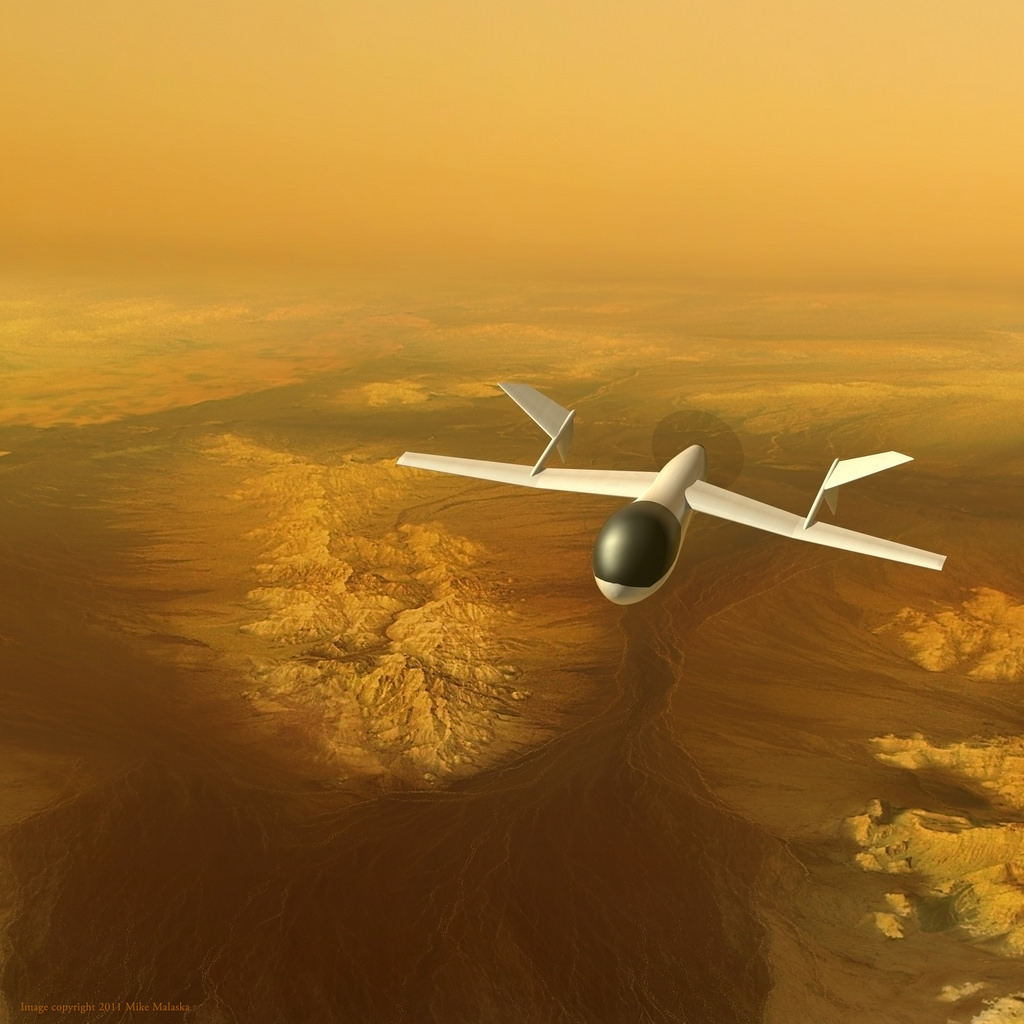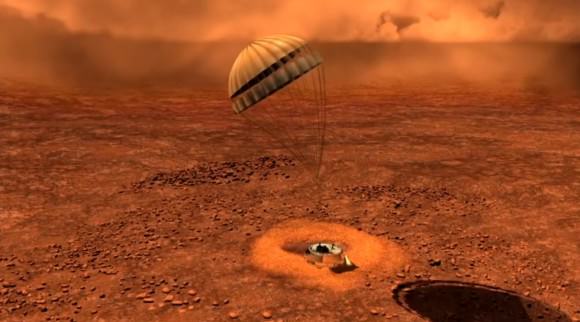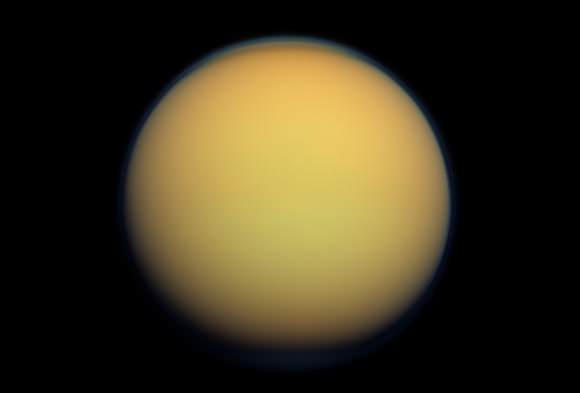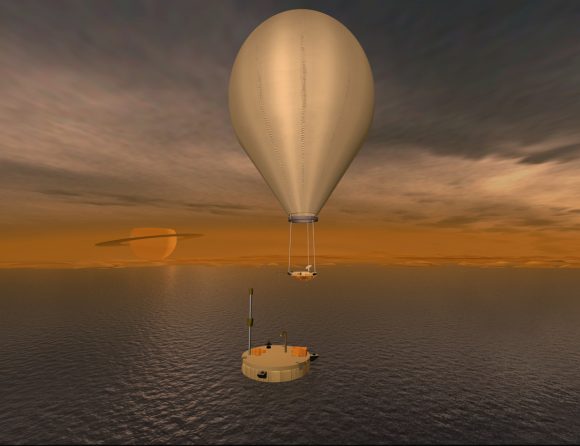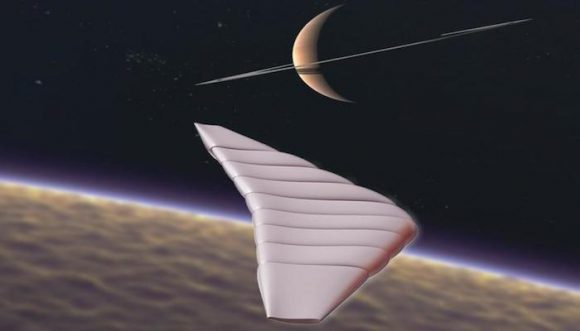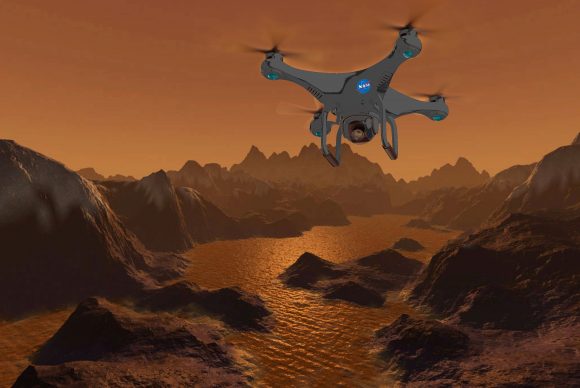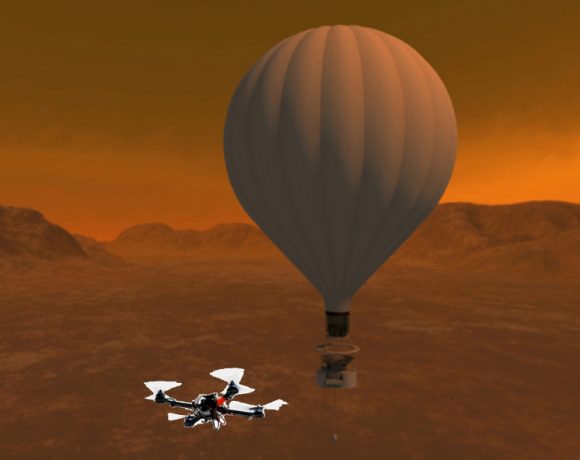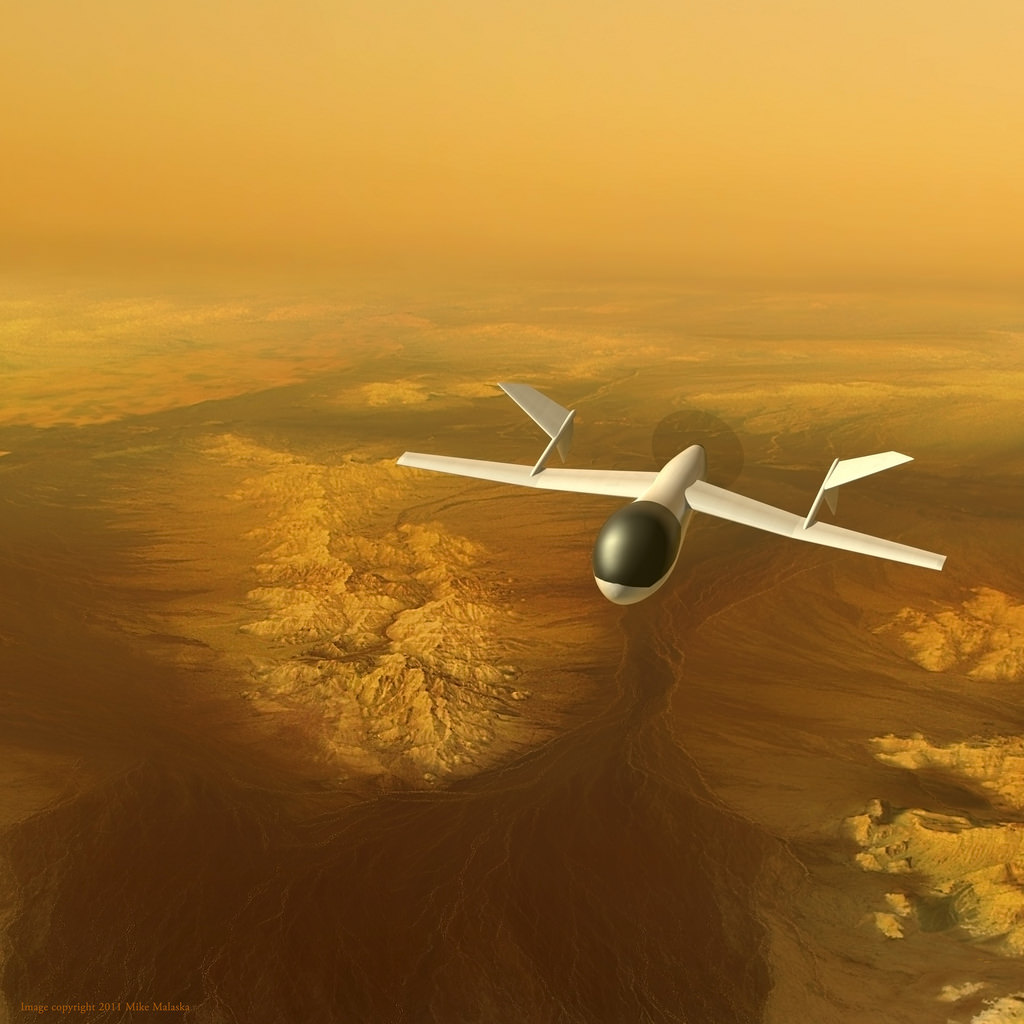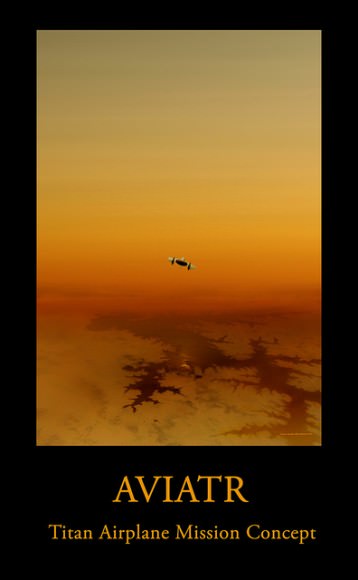As you probably know, NASA recently announced plans to send a mission to Jupiter’s moon Europa. If all goes well, the Europa Clipper will blast off for the world in the 2020s, and orbit the icy moon to discover all its secrets.
And that’s great and all, I like Europa just fine. But you know where I’d really like us to go next? Titan.
Titan, as you probably know, is the largest moon orbiting Saturn. In fact, it’s the second largest moon in the Solar System after Jupiter’s Ganymede. It measures 5,190 kilometers across, almost half the diameter of the Earth. This place is big.
It orbits Saturn every 15 hours and 22 days, and like many large moons in the Solar System, it’s tidally locked to its planet, always showing Saturn one side.
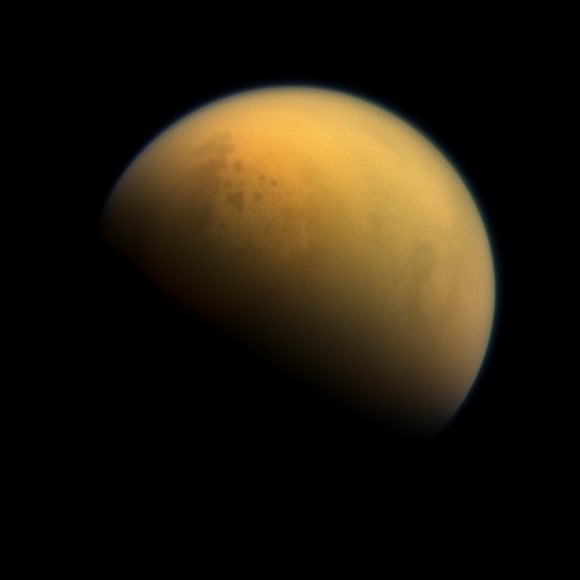
Before NASA’s Voyager spacecraft arrived in 1980, astronomers actually thought that Titan was the biggest moon in the Solar System. But Voyager showed that it actually has a thick atmosphere, that extends well into space, making the true size of the moon hard to judge.
This atmosphere is one of the most interesting features of Titan. In fact, it’s the only moon in the entire Solar System with a significant atmosphere. If you could stand on the surface, you would experience about 1.45 times the atmospheric pressure on Earth. In other words, you wouldn’t need a pressure suit to wander around the surface of Titan.
You would, however, need a coat. Titan is incredibly cold, with an average temperature of almost -180 Celsius. For you Fahrenheit people that’s -292 F. The coldest ground temperature ever measured on Earth is almost -90 C, so way way colder.
You would also need some way to breathe, since Titan’s atmosphere is almost entirely nitrogen, with trace amounts of methane and hydrogen. It’s thick and poisonous, but not murderous, like Venus.
Titan has only been explored a couple of times, and we’ve actually only landed on it once.
The first spacecraft to visit Titan was NASA’s Pioneer 11, which flew past Saturn and its moons in 1979. This flyby was followed by NASA’s Voyager 1 in 1980 and then Voyager 2 in 1981. Voyager 1 was given a special trajectory that would take it as close as possible to Titan to give us a close up view of the world.

Voyager was able to measure its atmosphere, and helped scientists calculate Titan’s size and mass. It also got a hint of darker regions which would later turn out to be oceans of liquid hydrocarbons.
The true age of Titan exploration began with NASA’s Cassini spacecraft, which arrived at Saturn on July 4, 2004. Cassini made its first flyby of Titan on October 26, 2004, getting to within 1,200 kilometers or 750 miles of the planet. But this was just the beginning. By the end of its mission later this year, Cassini will have made 125 flybys of Titan, mapping the world in incredible detail.
Cassini saw that Titan actually has a very complicated hydrological system, but instead of liquid water, it has weather of hydrocarbons. The skies are dotted with methane clouds, which can rain and fill oceans of nearly pure methane.
And we know all about this because of Cassini’s Huygen’s lander, which detached from the spacecraft and landed on the surface of Titan on January 14, 2005. Here’s an amazing timelapse that shows the view from Huygens as it passed down through the atmosphere of Titan, and landed on its surface.
Huygens landed on a flat plain, surrounded by “rocks”, frozen globules of water ice. This was lucky, but the probe was also built to float if it happened to land on liquid instead.
It lasted for about 90 minutes on the surface of Titan, sending data back to Earth before it went dark, wrapping up the most distant landing humanity has ever accomplished in the Solar System.
Although we know quite a bit about Titan, there are still so many mysteries. The first big one is the cycle of liquid. Across Titan there are these vast oceans of liquid methane, which evaporate to create methane clouds. These rain, creating mists and even rivers.
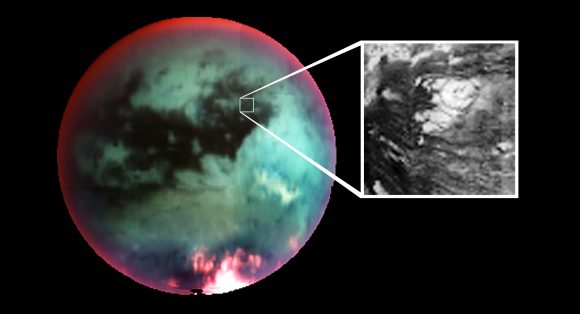
Is it volcanic? There are regions of Titan that definitely look like there have been volcanoes recently. Maybe they’re cryovolcanoes, where the tidal interactions with Saturn cause water to well up from beneath crust and erupt onto the surface.
Is there life there? This is perhaps the most intriguing possibility of all. The methane rich system has the precursor chemicals that life on Earth probably used to get started billions of years ago. There’s probably heated regions beneath the surface and liquid water which could sustain life. But there could also be life as we don’t understand it, using methane and ammonia as a solvent instead of water.
To get a better answer to these questions, we’ve got to return to Titan. We’ve got to land, rove around, sail the oceans and swim beneath their waves.
Now you know all about this history of the exploration of Titan. It’s time to look at serious ideas for returning to Titan and exploring it again, especially its oceans.
Planetary scientists have been excited about the exploration of Titan for a while now, and a few preliminary proposals have been suggested, to study the moon from the air, the land, and the seas.
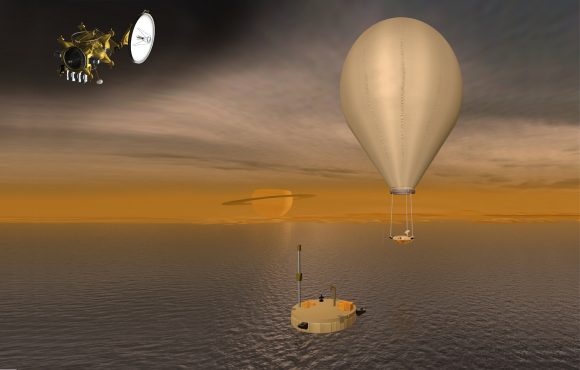
First up, there’s the Titan Saturn System Mission, a mission proposed in 2009, for a late 2020s arrival at Titan. This spacecraft would consist of a lander and a balloon that would float about in the atmosphere, and study the world from above. Over the course of its mission, the balloon would circumnavigate Titan once from an altitude of 10km, taking incredibly high resolution images. The lander would touch down in one of Titan’s oceans and float about on top of the liquid methane, sampling its chemicals.
As we stand right now, this mission is in the preliminary stages, and may never launch.
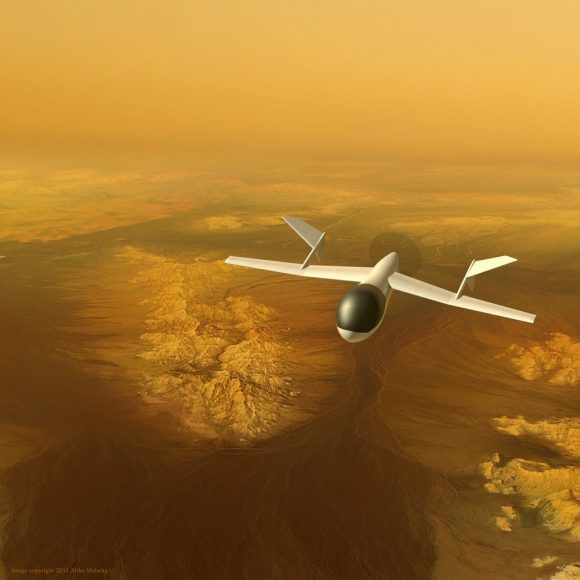
In 2012, Dr. Jason Barnes and his team from the University of Idaho proposed sending a robotic aircraft to Titan, which would fly around in the atmosphere photographing its surface. Titan is actually one of the best places in the entire Solar System to fly an airplane. It has a thicker atmosphere and lower gravity, and unlike the balloon concept, an airplane is free to go wherever it needs powered by a radioactive thermal generator.
Although the mission would only cost about $750 million or so, NASA hasn’t pushed it beyond the conceptual stage yet.
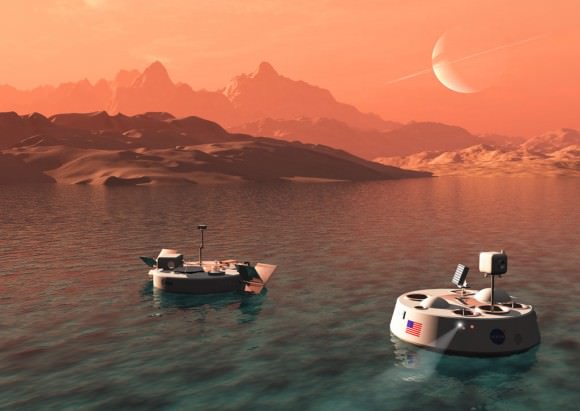
An even cooler plan would put a boat down in one of Titan’s oceans. In 2012, a team of Spanish engineers presented their idea for how a Titan boat would work, using propellers to put-put about across Titan’s seas. They called their mission the Titan Lake In-Situ Sampling Propelled Explorer, or TALISE.
Propellers are fine, but it turns out you could even have a sailboat on Titan. The methane seas have much less density and viscosity than water, which means that you’d only experience about 26% the friction of Earth. Cassini measured windspeeds of about 3.3 m/s across Titan, which half the average windspeed of Earth. But this would be plenty of wind to power a sail when you consider Titan’s thicker atmosphere.
And here’s my favorite idea. A submarine. This 6-meter vessel would float on Titan’s Kraken Mare sea, studying the chemistry of the oceans, measuring currents and tides, and mapping out the sea floor.
It would be capable of diving down beneath the waves for periods, studying interesting regions up close, and then returning to the surface to communicate its findings back to Earth. This mission is in the conceptual stage right now, but it was recently chosen by NASA’s Innovative Advanced Concepts Group for further study. If all goes well, the submarine would travel to Titan by 2038 when there’s a good planetary alignment.
Okay? Are you convinced? Let’s go back to Titan. Let’s explore it from the air, crawl around on the surface and dive beneath its waves. It’s one of the most interesting places in the entire Solar System, and we’ve only scratched the surface.
If I’ve done my job right, you’re as excited about a mission to Titan as I am. Let’s go back, let’s sail and submarine around that place. Let me know your thoughts in the comments.


